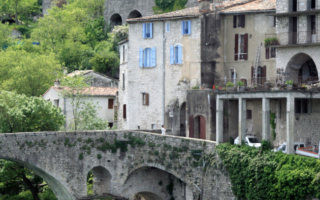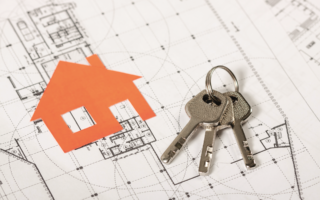Buying and Renovating an Auction Property

From Bougies to Bank to Buy
Whilst having a drink with my husband, James, and an architect friend one evening in one of the cafés in the beautiful Bastide town of Monpazier, the conversation turned towards the subject of an interesting property in the village that would be soon coming up for auction. As an ex-estate agent in France I was intrigued, and having downed our drinks, the three of us walked to the property to inspect it and try to get a peep through the window.
What we saw was certainly enough to whet our appetites, so I immediately decided to approach the local notaire the following morning to arrange a proper viewing and find out more about the property and the forthcoming auction. A few days later we were being shown around this property which had been empty for probably 15 years and was being sold as the owner had died leaving no living relatives to inherit the property. As we walked through the front door there was the familiar damp smell associated with empty houses but we could see the potential. There were original terracotta floor tiles and fantastic old beams, but the rooms had been divided up, not by our usual partition walls but instead by odd bits of wood and cardboard! We could barely get around the property as there were so many pieces of wood that the owner must have hoarded over decades. We can only assume he was a menusiere. We gingerly climbed the staircase, avoiding the gaping holes and found two rooms with rotten floorboards throughout and then another staircase to an attic. It was once we had climbed up into the attic space that we were sold on the property. The side wall of the house was built using the old wattle and daub technique, although it was only the upright wooden beams which remained. This gave us the chance to see out across the rooftops to the glorious countryside beyond, and imagine what we could do with the attic space.
Later that evening we sat at home with sketchpads, trying to find a suitable layout plan for a small town house with no windows to the rear. We did our sums, using my knowledge to work on the re-sale value and James’ experience in the French building trade built-up over 18 years, to work out some costings. We decided that we would participate in the auction on 18th April 2008. In order do so we needed to lodge personal details with the notaire’s office and bring a bankers draft for nearly 3000€ on the day of the auction.
Finally the day came and it was with nervous excitement that we entered the office along with an assortment of prospective buyers: one other older English couple, a young French couple, a group of French families and a Marchant de Bien (professional property dealer). We were a little embarrassed when we saw the Marchant de Bien as he had been trying to find the property a few days earlier when James had told him he knew nothing about a property for sale, trying to eliminate any competition before the auction! We were given our number and we took a seat at the back of the room. The whole process of “aux encheres” (auction bidding) was new to us so the procedure was explained. Basically the auctioneer, who had come from Bordeaux, had a device with a number of small candles, rather like birthday cake candles, which she would light one after the other. It had been agreed that the guide price was 14,500€ which would be the starting price with incremental bids of 500€. The first candle was lit and the auction was underway. People started bidding and as each candle burnt out another was duly lit. This process continued but the bidding slowed down. We were on the 6th candle when the bidding had stopped at our offer. At this point it was explained that another candle must be lit and allowed to burn out and that only then, provided nobody put in a counter bid, the property would be ours. We had set our own personal limit on the property at 30,000€ the evening before over a glass of wine, but we then realised that this would most likely be the same limit for other bidders and so we put our figure up to 30,500€. We waited for what appeared to be an eternity. As the 7th candle burnt down, anxious not to make eye-contact with anybody and with both of us having our fingers crossed, we were thankful that we had decided to go up to 30,500€ as this was the final bid. Finally the candle burnt out and the property was ours. The purpose of this final candle is to allow anybody else to make a counter offer at the last minute. If another offer had been made during that time then a further candle would have had to be lit and the process repeated.
We signed the papers for the “compromis de vente” although in the case of an auction there is no period of reflection for the buyer. There is, however, a clause which would allow anybody to come forward in the following 10 days and buy the property provided they offered 10% more than the winning bid at the auction. Fortunately this did not happen and so we were required to pay all the legal fees, which in the case of purchase “aux encheres” is about 12%. We were given 45 days to make the balance payment for the property.
Secure in the knowledge that the property was going to be ours, we enlisted the help of our friend the architect to draw up some plans and we duly got “devis” for the work. We also needed to speak to our accountant to determine the best way of financing the purchase of the property. As the property would not be our main residence in France, we would be liable for capital gains tax, which we wanted to minimize. We decided the best way forward would be to set up an SCI which would own the property and have our building company contracted to do the work which would therefore be able to issue factures to the SCI which the SCI to offset against the capital gain. This enables us to operate cost-effectively and within the law. Another advantage to working this way is that our building company has full assurance decennale which would be useful when selling the property as the new owner would benefit from this. We decided to call the SCI “Bastide Renovation” and arranged with the notaire to set up this company to enable the final completion papers to be signed in the name of Bastide Renovation. Setting up the company involved very little work of our part but the notaire has a considerable amount of paperwork to register the SCI which would take several weeks, but with the 45 days we knew that it could all be achieved within the necessary timescale.
We knew that, once we had the plans sketched out, we would need to obtain planning approval which would probably have to go through the “Batiment de France” as the property lies within 100 metres of a church and in a bastide town. We had friends who had tried for months to get plans passed, resulting in several sets of plans being sent to the authorities by their architect without any real response. We decided that, as we hoped to start work in the autumn, it would be better to simply call the planners and make an appointment for someone in their office to visit the property. We were thrilled to get an appointment arranged for the following week and when we met Monsieur Gondrand it was so refreshing to find somebody as excited by the project as we were. We discussed the exposed side wall and what we could do with the colombage to create a balcony as well as a very light area in the attic room. It was agreed that, provided we kept the original wooden colombage, we could render up the side of the house leaving the colombage as an open balcony from waist-height and create a glass wall which would be our new exterior wall, 1.5m in from the existing external wall. This would mean that the roof line would not change, the property would still look visibly very similar, but we would have gained a light airy space in the attic and a large covered balcony. Approval was given verbally at this stage but we needed to wait for the official papers to come back. We knew we would get permission for the balcony and so we started in earnest to put together a Devi for the work which we would then take to the bank in order to secure a loan for the work.
A couple of days later I made an appointment with our bank, Credit Immobilier de France in Bergerac, to make the mortgage application. After putting all the paperwork together, including the planning approval, we then made our formal application for the mortgage which then had to wait approval. In the meantime I arranged to get electricity and water supplies to the property restored. This was a relatively simple procedure as the property had previously had both water and electric supplies. It was just a case of being there at the allotted time to meet the service engineers and signing the necessary papers.
Eight weeks later we got the mortgage approval and, after signing yet more papers, then had to wait a further 10 days of “cooling off period” before we could access the money. During this time we also needed to secure the finance against the property which was a further duty for the notaire. Finally, the project was underway!
Read Part 2 of this story here.
© Vanessa Hopkins 2009
Tel: 05 53 36 34 59
www.hopkinsrenovations.com
Share to: Facebook Twitter LinkedIn Email
More in banking, countryside, guides, renovation, tax, villages, wine
Leave a reply
Your email address will not be published. Required fields are marked *



